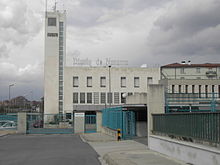Diario de Navarra
| Type | Regional daily newspaper |
|---|---|
| Owner(s) | Grupo La Información |
| Publisher | Grupo La Información |
| Founded | 1903 |
| Political alignment | |
| Language | Spanish |
| Headquarters | Pamplona |
| Country | Spain |
| ISSN | 1577-6301 |
| OCLC number | 31791830 |
| Website | diariodenavarra |
Diario de Navarra (also called El Diario de Navarra; Spanish: Navarra Daily) is a regional newspaper based in Pamplona, Spain. The paper has been in circulation since 1903.
History and profile
[edit]
Diario de Navarra was established by five local families in 1903.[1] The paper has its headquarters in Pamplona.[2][3] It is part of the company, Grupo La Información, owned by founding families.[1] The publisher is also the same company.
In the late 1970s Diario de Navarra supported the view that the province of Navarre should remain part of Spain and be independent of Euskadi.[4] On 22 August 1979, ETA attempted to assassinate the editor of the paper, José Javier Uranga, allegedly due to this support.[4] On the other hand, the paper has a neutral political stance.[5]
Circulation
[edit]Diario de Navarra sold 63,312 copies in 1993.[6] The paper had the highest level of readership in the Navarre province in 2001.[5] It was the 13th best selling newspaper in Spain in 2003.[2] In the period of 2009–2010 the paper sold 49,065 copies.[7] The circulation of the paper was 44,000 copies in 2011.[8]
References
[edit]- ^ a b "El Diario de Navarra: the leading Spanish regional daily" (PDF). WAN IFRA. Archived from the original (PDF) on 4 March 2016. Retrieved 22 February 2015.
- ^ a b Deirdre Kevin (2003). Europe in the Media: A Comparison of Reporting, Representation, and Rhetoric in National Media Systems in Europe. Mahwah, NJ; London: Lawrence Erlbaum Associates, Publishers. p. 58. ISBN 978-1-135-70499-5.
- ^ Gabriel Jackson (2012). Spanish Republic and the Civil War, 1931-1939. Princeton, NJ: Princeton University Press. p. 555. ISBN 978-1-4008-2018-4.
- ^ a b Paul Preston (1990). The Triumph of Democracy in Spain. London: Routledge. p. 179. ISBN 978-0-4150-4314-4.
- ^ a b Jan Mansvelt Beck (2004). Territory and Terror: Conflicting Nationalisms in the Basque Country. London; New York: Routledge. pp. 55–56. ISBN 978-1-134-27605-9.
- ^ Edward F. Stanton (1999). Handbook of Spanish Popular Culture. Westport, CT: Greenwood Press. p. 199. ISBN 978-0-3132-9885-1.
- ^ Antonio Luzon; Monica Torres (2012). "Visualizing PISA scientific literature versus PISA public usage". In Miguel A. Pereyra; Hans-Georg Kotthoff; Robert Cowen (eds.). PISA Under Examination: Changing Knowledge, Changing Tests, and Changing Schools. Rotterdam; Boston; Taipei: Sense Publishers. p. 292. ISBN 978-94-6091-740-0.
- ^ "Diario de Navarra". Cesanamedia Italy. Archived from the original on 23 February 2015. Retrieved 23 February 2015.
